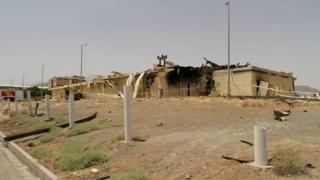Home » World News »
Iran says fire at nuclear site caused by sabotage
Iran’s nuclear body has said that a fire last month at a major nuclear facility at Natanz was caused by sabotage.
But the Iran’s Atomic Energy Organisation (IAEO) did not say who they believe is behind the incident.
Some Iranian officials have previously said the fire might have been the result of cyber sabotage.
It comes after a number of fires and explosions at power facilities and other sites over the last few weeks.
Behrouz Kamalvandi, a IAEO spokesperson, told state TV channel al-Alam on Sunday that “security authorities will reveal in due time the reason behind the [Natanz] blast”.
The fire hit a central centrifuge assembly workshop. Centrifuges are needed to produce enriched uranium, which can be used to make reactor fuel but also material for nuclear weapons.
Interactive
Incident at Natanz nuclear site
5 July
29 June
Mr Kamalvandi said last month that Iran would replace the damaged building with more advanced equipment, but the fire could slow down the development and production of advanced centrifuges “in the medium term.”
An article by Iran state news agency Irna previously addressed the possibility of sabotage by adversaries such as the United States and Israel, but did not accuse either of the countries directly.
Why is Natanz significant?
Natanz, about 250km (150 miles) south of the capital Tehran, is Iran’s largest uranium enrichment facility.
Earlier this month, Bloomberg published details of a report by the the International Atomic Energy Agency (IAEA), the UN’s nuclear watchdog, which concluded that Iran was attempting to boost uranium enrichment at the plant.
If true, the move would be in violation of a 2015 nuclear deal Iran signed with several world powers.
As part of the deal, Iran agree only to produce low-enriched uranium, which has a 3-4% concentration of U-235 and can be used to produce fuel for nuclear power plants. Weapons-grade uranium is 90% enriched or more.
Iran also agreed to install no more than 5,060 of the oldest and least efficient centrifuges at Natanz until 2026, and not to carry out any enrichment at its other underground facility, Fordo, until 2031.
In exchange for concessions to it’s nuclear programme, Iran was granted relief from international sanctions.
But last year, Iran began rolling back its commitments after US President Donald Trump abandoned the nuclear accord and reinstated crippling economic sanctions.
In November, Iran said it had doubled the number of advanced centrifuges being operated at Natanz and had begun injecting uranium hexafluoride gas into centrifuges at Fordo.
Natanz is one of several facilities being monitored by the IAEA to ensure Iran’s compliance with the 2015 deal.
On Saturday, IAEA’s new chief Rafael Grossi announced he would visit Tehran on Monday to request access to two suspected former nuclear sites. The IAEA said it suspects activities related to the development of nuclear weapons was carried out in the earlier 2000s at these sites.
Iran has previously insisted its nuclear programme is not intended for military use. Officials have also denied that Mr Grossi’s visit is related to moves by the United States at the UN Security Council to reimpose international sanctions on Tehran, state media reported.
Source: Read Full Article





